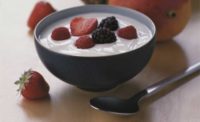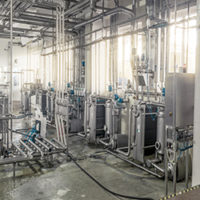By Jessica Letscher and Drew Nakajima, Alfa Laval Tank Equipment, Exton, Pa.
The rapid rise in the popularity of Greek yogurt is apparent to anyone who has seen the yogurt aisle at the grocery store recently. Showing no signs of slowing down, the USDA recently awarded a contract to supply high-protein Greek-style yogurt in the National School Lunch Program. Whether it’s the perceived health benefits of this type of yogurt or the pleasing thick texture, people are choosing Greek yogurt over regular yogurt in droves.
Both regular and Greek yogurts are made the same way with milk and bacteria cultures. Where they differ is that Greek yogurt is then strained to remove the liquid whey from it. With that, it takes roughly four times the amount of milk to make an equivalent amount of Greek yogurt as for regular yogurt. This straining creates Greek yogurt’s thick texture that people prefer over regular yogurt. There is nearly twice the amount of protein in Greek yogurt as regular yogurt, so there is basically twice the amount of solids in it.
Rumor has it that cleaning tanks with Greek yogurt residue is cumbersome, to say the least. The head of Alfa Laval Tank Equipment, Bob Delaney, discovered this fact when he finished a container of Greek yogurt and left the dirty spoon out for his wife to clean. To make a long story short, she was less than thrilled with the cleaning process. However, this incident inspired Bob to challenge the North American Tank Competency Center, part of the Alfa Laval Group, to find the best way to clean a Greek yogurt tank in a typical manufacturing setting.
The team chose to compare a static spray ball, rotary sprayhead, and a rotary jethead to find out how well they clean Greek yogurt residue from a tank. All three devices are available in 3-A SSI-compliant versions. However, the three machines use differing technologies to clean tanks.
3 cleaning technologies to use on Greek yogurt residue
Alfa Laval Tank Equipment offers a full line of rotary jetheads, rotary sprayheads and static spray balls to cover all tank cleaning needs.
Static spray balls use a sheeting effect to clean less-challenging residues in a cost-effective manner.
Rotary sprayheads offer higher cleaning efficiency than static spray balls. As the spray head rotates, its fans produce a variable sheeting effect that provides 360-degree cleaning coverage with average water jet impact. This enables the optimization of cleaning procedures and saves water, chemicals and energy.
Rotary jethead machines combine pressure and flow to create high-impact cleaning jets. Cleaning occurs at the point in which the concentrated stream impacts the surface. It is this impact and the tangential force that radiates from that point which blasts contaminants from the surface and scours the tank interior.
In conjunction with this impact, the machines are engineered to rotate in a precise, repeatable and reliable 360-degree pattern. This full-coverage, global indexing pattern is designed to ensure the entire tank interior is cleaned. Not only are rotary jetheads ideal for cleaning difficult residues, they are also engineered to clean much faster and use significantly less water and cleaning chemicals than other tank cleaning devices.
Cleaning Greek yogurt, conventional yogurt residues
In addition to comparing cleaning methods, the team also researched the level of cleanability of regular yogurt versus Greek yogurt.
Tests were done by applying a film of both types of yogurt in a test tank and letting it settle for four hours to create a worst-case scenario. The cleaning water was heated to the desired temperature and hooked up to the tank. Finally the spray device was mounted, starting with the static spray ball. Tests were run under the following conditions:
| Equipment | Pressure (psig) | Flow (gallons per minute) | Run Time (minutes) | Temperature (degrees F) |
| Rotary jethead | 40 | 34 | 10 | 180 |
| Rotary sprayhead | 40 | 44 | 10 | 180 |
| Static spray ball | 40 | 49 | 10 | 180 |
The purpose of this experiment sought to answer the following questions:
1. Is Greek yogurt truly harder to clean than regular yogurt?
2. Between a static spray ball, a rotary spray ball, and a rotary jet head, which is the most effective spray device in cleaning the inside of a tank with Greek yogurt residue?
Results of cleaning Greek yogurt residue from tanks
In every single test, the regular yogurt was much easier to clean than Greek yogurt. This confirmed the initial belief that this would be the case.
Although all three cleaning devices provided an adequate level of tank cleaning for regular yogurt, the rotary jethead was the only device to fully clean the entire Greek yogurt tank, including the roof.
| Tank sides and bottom | Tank roof | |||
| Equipment | Regular yogurt | Greek yogurt | Regular yogurt | Greek yogurt |
| Static spray ball | Light residue | Substantial residue | Moderate residue | Substantial residue |
| Rotary sprayhead | Clean | Clean | Minimal residue | Moderate residue |
| Rotary jethead | Clean | Clean | Clean | Clean |
Test finds rotary jethead cleans Greek yogurt residue best
As the only 3-A compliant rotary impingement style tank cleaning machine on the market, and because it offers the best level of clean for Greek-style yogurt, the team recommends the Aseptic 1 rotary jethead for the most effective cleaning of Greek yogurt. For the cleaning of regular yogurt, a rotary sprayhead adequately does the job.
For more information on how to clean any tank, vessel, tote or trailer, the team at Alfa Laval Tank Equipment welcomes any challenge. Committed to supplying a "Better Way to Clean" all types of tanks and vessels for over 50 years, the Gamajet and Toftejorg ranges of tank cleaning machines have become the first choice in cleaning for many of the world's largest dairies and trucking fleets. Designed to provide exceptional cleanability, better end-product quality, greater overall output, and reduced operating costs, a full line of rotary jethead, rotary sprayhead, and static spray balls are available.
For more information, visit www.Gamajet.com or call 610-408-9940.




